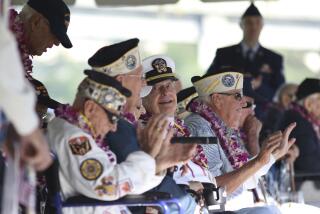Key WW II Mission Recalled : Doolittle’s Raiders Reunite in Torrance
- Share via
Gen. Jimmy Doolittle’s Tokyo raiders gathered Friday to celebrate the 45th anniversary of their bombing mission, but frail health prevented the man who led the historic air strike from joining the party.
Doolittle, 91, was not feeling well enough to make the annual reunion, although he was expected to attend festivities Saturday, the final day of the three-day celebration, said Art La Vove, a spokesman for the group.
“It’s too bad he couldn’t make it, but you know he’s getting along in years and uses a wheelchair to get around,” La Vove said.
‘Quite a Spectacle’
Twenty-five of Doolittle’s 80 raiders showed up at the reunion luncheon at Torrance Municipal Airport and were met by two vintage B-25s, the same type of twin-engine bombers used in the mission that proved America could strike back against Japan.
“These guys haven’t seen one of those babies in the flesh for years,” La Vove said. “It was quite a spectacle.”
Four of the restored B-25s were supposed to have landed at the airstrip next to the restaurant where lunch was served, but because of mechanical problems and heavy cloud cover, only two of the old war-horses, Pacific Princess and Heavenly Body, made it in to the airport.
This year’s reunion--there’s been one every year since 1946--was held at the Doolittle’s Raiders restaurant, which was decked out with World War II memorabilia.
The Raiders--46 of them are still living--were feeling more festive than nostalgic.
“The reason we get together is to have a good time and see each other,” said former pilot Everett (Brick) Holstrom. “Gen. Doolittle gave us the first party in Miami and we had so much fun we decided to do it every year.”
The men’s pride in the courageous April 18, 1942, raid on Tokyo shone through the party atmosphere.
“We were young and we didn’t really give a damn,” recalled former bombardier Howard Sessler. “When they said ‘you’re going to help the war effort,’ all of us thought it was about time we did something.
“We weren’t scared. Nobody knew what it was to be shot at. It was just like a sport. Like football or basketball.”
Good News for U.S.
The raid on Tokyo was the first good news for the United States in the months that followed devastating losses suffered at Pearl Harbor.
Doolittle’s feat, an “impossible” attack by B-25s launched from an aircraft carrier, won him the Congressional Medal of Honor and inspired the movie “Thirty Seconds Over Tokyo.” He was portrayed by Spencer Tracy.
Although he went on to lead other commands and retire at the end of the war as a lieutenant general, Doolittle, who lives in the Central California coastal community of Carmel-by-the-Sea, is most famous for the Tokyo raid.
A turning point in the war, the raid was the first American victory against the Axis powers, who had everything going their way until then. There seemed to be no way the ill-prepared United States could strike back until Doolittle’s volunteers in 16 bombers lurched off the aircraft carrier Hornet.
Three Weeks’ Training
The crews had trained for three weeks to get the heavy planes off the short deck of a carrier, a task considered impossible by many military experts.
Doolittle flew the lead plane, giving himself the shortest takeoff run of all.
After the bombing, the raid went astray. The pilots, short of gas, could not reach their planned landing field in China. About 64 raiders, including Doolittle, bailed out over China and were saved by the Chinese.
Others died in crash landings or were captured by the Japanese, who executed three of them. One plane landed in Russia, which held five crewmen prisoner for a year.
But the attack was heralded as a success. It forced the Japanese to hold back fighter forces to protect Tokyo that could have been used elsewhere in the Pacific, tilting the odds of future battles in America’s favor.
It forced the Japanese to push eastward to enlarge the buffer zone around the home islands, setting the stage for the battle of Midway six weeks later, in which American air and sea power turned the tide of the war.
More to Read
Sign up for Essential California
The most important California stories and recommendations in your inbox every morning.
You may occasionally receive promotional content from the Los Angeles Times.










